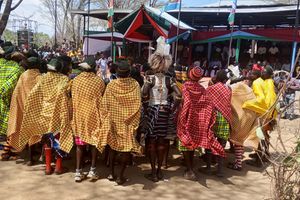No record is achieved by planting mangroves in the wrong areas

A degraded mangrove area requiring assisted regeneration in Lamu County
What you need to know:
- Mangrove forests can capture and store 10 times more carbon than their terrestrial counterparts.
- Along the Kenyan coast, mangroves have been harvested and traded for centuries.
On April 24, the Daily Nation ran a story of an Australian national seeking to break Guinness world record through mangrove planting. More than 30,000 mangrove trees were planted in less than 24 hours in an intertidal area without history of vegetation.
This exercise was supervised by the Kenya Forest Service, conservation groups and community leaders; and broadcast live on national television and social media. But questions arise. How was the planting site selected? Was the planting guided by science or mere publicity? And did we really hit a new world record in mangrove planting?
This exercise reminded me of my high school mathematics lessons. The teacher would give us marks for correct method used and for the answer derived. In the mangrove tree planting exercise, the score is zero for both the approach and the expected results. This is despite the publicity and resources used.
Let me explain. In my career life spanning more than 30 years, I have studied mangrove management throughout the world. Our award-winning plantations at Gazi Bay in Kwale County are perhaps the best studied mangrove forests on earth. Scientists, practitioners and students travel from all over the world to Gazi village to study mangrove restoration practices. For your information, Gazi is located only 15 kilometres from where the Australian’s event was taking place.
Why mangroves?
Mangroves are extraordinary forests. Apart from storing huge stocks of carbon in both above and below ground components, mangroves provide harvest able wood and non-wood products, support fisheries, and protect shorelines from erosion. It is the carbon storage potential that has interested governments, private sector, civil society and the public to want to restore degraded mangroves for climate, community, and biodiversity benefits.
Mangrove forests can capture and store 10 times more carbon than their terrestrial counterparts. Along the Kenyan coast, mangroves have been harvested and traded for centuries. In the 1950s, mangrove poles, charcoal and barks were ranked third among Kenya's export products. Between 1965 and 1982, this export averaged 670,000 poles per year; with a maximum of 4,000,000 poles in 1981.
Over-exploitation of the forests led to a presidential ban on export of mangrove poles in 1982; a move that affected the economy of coastal people tremendously, particularly in Lamu.
National mangrove management plan
To regulate utilisation of mangrove resources, the government developed a national mangrove ecosystem management plan. The plan provides a roadmap towards rehabilitation, conservation and sustainable utilisation of mangrove resources between 2017 to 2027. According to the plan, there are 60,000 hectares of mangrove forests in Kenya; 70 per cent of which are in Lamu County. At least 40 per cent of mangroves in Kenya have been degraded by human and natural factors. The plan has elaborated where these degraded mangrove areas are located and priority actions in each of the coastal counties.
The management of mangrove forests requires expertise from different disciples. That is why the management plan has proposed the establishment of national and county mangrove management committees to advise the government on issues related to mangrove conservation. The committees are supposed to advise on harvesting quota, restoration plans as well on mangrove areas converted for other land uses.
Factors affecting restoration success
It is difficult to generalise planting sites for successful mangrove restoration as this fully depends on local environmental conditions and the species to be planted. Hydrologic regime is the single most important factor governing the survival and subsequent growth of replanted mangrove seedlings. The amount of seawater reaching a targeted restoration site will determine salinity levels of the site and suitable species that can survive there. This factor was not given due considerations in the planting exercise carried out by the Australian.
Mangroves in Kenya are represented by nine tree species. These species exist as single or mixed stands along the intertidal areas depending on tidal regimes and salinities. The site where the Australian planted trees in Kwale County was an open sand flat devoid of vegetation. The Kenya Marine and Fisheries Research Institute (KMFRI) had already mapped this area as sand flat bordering landward mangroves. Such sites are natural gaps in mangrove ecosystems with extreme salinity and aridity during low tides. Due to extreme salinity and desiccating temperatures, the recently planted mangroves will all die off and thus no new Guinness world record will be achieved.
What could have been done?
The blame solely goes to the Kenya Forest Service (KFS) officials who supervised the exercise. KFS is expected to have provided degraded mangrove areas requiring assisted regeneration. Such degraded sites exist, particularly in Mombasa County; where such an important event could have taken place. There are many ongoing mangrove reforestation activities along the coast involving different stakeholders such as local communities, government agencies, NGOs, private sector and funding agencies. However, these initiatives face a number of operational challenges that lead to failure. More than 90 per cent of mangrove restoration failures have been associated with poor species-site matching, extreme changes in site conditions and lack of monitoring. The Australian’s exercise will suffer the challenges of species-site mismatch.
To respond to these challenges, KMFRI with support from UNEP and other agencies has developed regional guidelines on ecological mangrove restoration. These guidelines describe a step-by-step approach towards ecological mangrove restoration. They comprehensively analyse prevailing circumstances, sharing local lessons for best institutional arrangements and stakeholders’ engagement mechanisms that enable efficient implementation of restoration projects. KMFRI has embarked on domesticating the guidelines to suite local conditions and economies.
Dr Kairo is a chief scientist and mangrove expert at the Kenya Marine and Fisheries Research Institute




